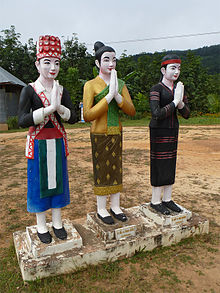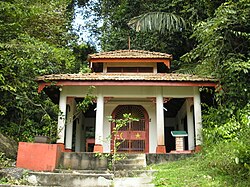Satsana Phi (Lao: ສາສນາຜີ, "religion of the gods [phi]") is a classificatory term for the ethnic religions practiced by 30.7% of the population of Laos. The same traditions are practiced by the Lao Isan and Thais of Thailand. These religions are of the pantheistic and polytheistic-animistic typology, often including shamanic roles.
The category comprehends traditions of the Lao and other Tai-Kadai folks, the Khmu and other Mon-Khmer folks, as well as religions of the Hmong-Mien (Hmongism and Yao Taoism), Tibeto-Burman, and other ethnic groups of Laos. Among the Lao, the Lao Loum and Lao Lom are predominantly Buddhist, while the Lao Theung and Lao Sung are predominantly Phiist.
Overview
_05.jpg/150px-Bo_Lek_Nam_Phi_(Nam_Pi_iron_mines)_05.jpg)
Phi (ຜີ, ผี, [pÊ°iË]) are tutelary gods of buildings or territories, of natural places, things or phenomena; they are also ancestral spirits and other spirits that protect people, and include malevolent spirits. Guardian deities of places, such as the phi wat (ຜີວັàº", ผีวัà¸") of temples and the lak mueang (ຫລັàºà»€àº¡àº·àºàº‡, หลัà¸à¹€à¸¡à¸·à¸à¸‡, [lak mɯËaÅ‹]) of towns are celebrated with communal gatherings and offerings of food. Gods of Hindu derivation are included in the pantheon; indigenous non-Hindu gods are called phi thaen (ຜີà»àº–ນ, ผีà¹à¸–น). Phi are ubiquitous, and some of them are connected with the universal elements: heaven, earth, fire, and water.
Lao people also believe in thirty-two spirits known as khwan (ຂວັນ, ขวัà¸, [kÊ°wan]) that protect the body, and baci (ບາສີ, [baË siË], ใบสี, [bÉ'j siË]) ceremonies are undertaken during momentous occasions or times of anxiety to bind the spirits to the body, as their absence is believed to invite illness or harm. The baci rite calls all thirty-two khwan back to bestow health, prosperity, and well-being on the affected participants. Cotton strings are tied around the wrists of the participants to keep the spirits in place. The ceremony is often performed to welcome guests, before and after making long trips, and as a curing ritual or after recovery from an illness; it is also the central ritual in the Lao Loum wedding ceremony and naming ceremony for newborn children.
In daily life, most people pay respect to the phi that reside in spirit houses, who are thought to protect the vicinity from harm. Offerings of flowers, incense, and candles are given, and the spirits are consulted during changes or times of hardness for protection and assistance. Natural deities include those that reside in trees, mountains, or forests.
Guardian spirits of people often include ancestors or angelic-beings who arrive at various points in life, better known as thewada. Malevolent spirits (phi phetu) include those khwan of people who were bad in past lives or died of tragic deaths, such as the ghastly phi pob (ຜີປàºàºš, ผีปà¸à¸š) and the vampirical phi dip (ຜີàº"ິບ, ผีà¸"ิบ). Deities associated with specific places such as the household, the river, or a grove of trees are neither inherently benevolent nor evil, and occasional offerings ensure their favor and assistance in human affairs.
The mophi

Mophi (mo-phi à»à»àºœàºµ, หมà¸à¸œà¸µ), "tellers", are locally trained shamans, specialists in the rituals and in communication with their personal spirits and gods in general. Using trances, sacred objects imbued with supernatural power, or saksit, possessions, and rituals like lam phi fa (ລຳຜີຟ້າ, ลำผีฟ้า, [lam pÊ°iË faË]) or baci, the shaman is often consulted during times of trouble, hauntings, and illness or other misfortune that might be caused by malevolent or unhappy spirits. They are also usually present during religious festivals.
Ceremonies
Ceremonies devoted to the phi commonly involve an offering of a chicken and rice wine. Once the phi have taken the spiritual essence of the offering, people may consume the earthly remains. The head of a household or the individual who wants to gain the favor of the gods usually performs the ritual. In many villages, a person, usually an older man believed to have special knowledge of the phi, may be asked to choose an auspicious day for weddings or other important events, or for household rites.
Each lowland village believes itself protected by the phi ban, which requires an annual offering to ensure the continued prosperity of the village. The village ritual specialist presides over this major ritual, which in the past often involved the sacrifice of a water buffalo and is still an occasion for closing the village to any outsiders for a day. To liang phi ban (feed the village spirit) also serves an important social function by reaffirming the village boundaries and the shared interests of all villagers.
For Satsana Phi followers, the cult of the ancestors is very important, although each ethnic group has different practices and beliefs. The Khmu call spirits hrooy, and they are similar to the phi of the Lao Loum; the house spirit is particularly important, and spirits of wild places are to be avoided or barred from the village.
Lamet have similar beliefs, and each village must have one godly ritualist (xemia), who is responsible for making all the sacrifices to village gods. He also supervises the men's communal house and officiates at the construction of any new houses. When a ritual practitioner dies, one of his sons is elected by the married men of the village to be his successor. If he has no sons, one of his brother's sons is chosen.
Ancestral spirits (mbrong n'a) are very important to the Lamet because they look out for the well-being of the entire household. They live in the house, and no activity is undertaken without informing them of it. The spirits of the ancestors are fond of buffalos; thus buffalo skulls or horns from sacrifices are hung at the altar of the ancestors or under the gable of the house. Numerous taboos regarding behavior in the house are observed to avoid offending ancestral spirits.
Hmong faith

The Hmong people also believe in a variety of gods (neeb), some associated with the house, some with nature, and some with ancestors. Every house has at least a small altar on one wall, which is the center of any ritual related to the household or its members. Annual ceremonies at Hmong New Year renew the general protection of the household and ancestral spirits. The deity of the door is important to household well-being and is the object of another annual ceremony and sacrifice.
As with other Lao groups, illness is frequently attributed to the action of spirits, and spirit practitioners are called to carry out curing rites. Two classes exist: ordinary practitioners and shamans. Ordinary priests or the household head conduct the household ceremonies and ordinary divinations. The shaman may be called on to engage in significant healing rituals.
According to Hmong belief, spirits reside in the sky, and the shaman can climb a ladder to the heavens on his magical horse and contact the spirits there. Sometimes illness is caused by one's soul climbing the steps to the sky, and the shaman must climb after it, locate it, and bring it back to the body in order to effect a cure.
During the ritual, the shaman sits in front of the altar astride a wooden bench, which becomes his or her horse. A black cloth headpiece covers vision of the present world, and as the shaman chants and enters a trance, he or she begins to shake and may stand on the bench or move, mimicking the process of climbing to heaven. The chant evokes the shaman's search and the negotiations with the heavenly spirits for a cure or for information about the family's fortune.
Hmong shamans are believed to be chosen by the gods, usually after a serious or prolonged illness. The illness would be diagnosed by another shaman as an initiatory illness and confrontation with death, which was caused by the deities. Both men and women can be summoned in this way by the deities to be shamans.
After recovery from the illness, the newly called shaman begins a period of study with a master shaman, which may last two or three years, during which time he or she learns the chants, techniques, and procedures of shamanic rites, as well as the names and natures of all the spirits that can bring fortune or suffering to people. Because the tradition is passed orally, there is no uniform technique or ritual; rather, it varies within a general framework according to the practice of each master and apprentice.
See also

- Chinese folk religion
- Vietnamese folk religion
- Mo (religion)
- Ua Dab
- Yao Taoism
References

Bibliography
- Yoshihisa Shirayama, Samlane Phompida, Chushi Kuroiwa. Malaria Control Alongside "Sadsana-Phee" (Animist Belief System) in Lao PDR. In: Modern Medicine and Indigenous Health Beliefs, Vol 37 No. 4 July 2006.
External links
- Lao Heritage Foundation: Baci Ceremony.

